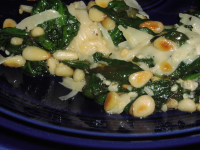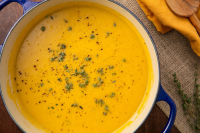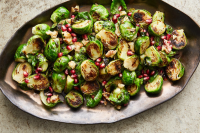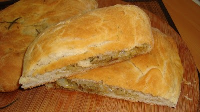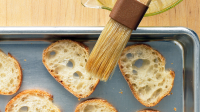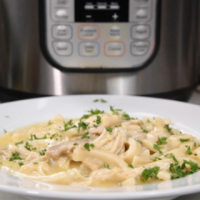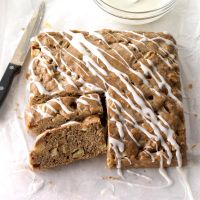SOURDOUGH BREAD | JAMIE OLIVER RECIPES

Making your own sourdough takes a bit of prep and know-how, but once you’ve got the knack and start developing your instincts, you’ll be hooked!
Total Time 50 minutes
Yield 1 loaf
Number Of Ingredients 8
Steps:
- The night before you want to bake, make the levain starter. Pour 50ml of tepid water into a large mixing bowl. Use your fingers to gently stir in the mature sourdough starter until fully dissolved, then repeat with the flour until smooth and combined.
- Leave, covered, in a warm place for at least 8 hours – it’s ready when lots of bubbles appear on the surface and the dough has a milky-sweet aroma.
- The next day, to make the final dough, pour 325ml of tepid water into a large mixing bowl and add 100g of the levain, which should float (the remaining levain can be fed and used as a new sourdough starter, or gifted to a friend). Use your fingers to gently stir it into the water until fully dissolved, then repeat with both flours. Cover with a damp cloth and rest in a warm place for 1 hour.
- Now add the salt and 25ml of tepid water, scrunching them into the dough until fully combined. Set aside, covered, in a warm place for 30 minutes.
- Wet your hand slightly and give the dough four folds in the bowl, one at each ‘corner’. This is one turn. Repeat this process another three times at 30-minute intervals, turning the dough four times in total across 2 hours. After the last turn, cover and leave to rise in a warm place for another 2 hours.
- To shape the loaf, tip the dough onto a clean surface and gently dust the top with a handful of semolina flour. Roughly shape into a round, being careful to keep as much air in the dough as possible. Rest, covered, for 30 minutes.
- Dust a basket or cane banneton with semolina flour (or you can simply use a medium bowl lined with a clean, floured tea towel). Lightly flour the dough again and flip it over, so the flour side is on the worktop. Set the dough in front of you and gently shape into a round. Turn the dough over, then place it in your floured basket, banneton or tea towel-lined bowl.
- Cover the dough with a shower cap (or oiled cling film) and allow to rest for 1 to 2 hours, or until increased in size by a quarter and looking bubbly. Transfer your dough, in its basket or bowl, to the fridge to rise for another 12 to 16 hours, or until bubbly and risen by another quarter.
- Place a heavy lidded casserole pot on the bottom shelf of the oven, then preheat to full whack (240ºC/464ºF/gas 9).
- Bring your loaf out of the fridge and scatter semolina over the top. Working carefully, remove the hot pot from the oven, take off the lid and gently tip your dough out into the pot, so now the pattern should be the right way up. Score it with a sharp knife, holding it at a 40 degree angle to the surface of the dough for the best slashes, then carefully cover and return to the oven.
- Reduce the temperature to 230ºC/446ºF/gas 8 and bake for 30 minutes. Carefully remove the lid and bake for a final 20 minutes, or until a malted golden brown. Remove to a wire rack to cool.
Nutrition Facts : Calories 160 calories, FatContent 0.7 g fat, SaturatedFatContent 0.2 g saturated fat, ProteinContent 5.5 g protein, CarbohydrateContent 34.8 g carbohydrate, SugarContent 0.7 g sugar, SodiumContent 0.9 g salt, FiberContent 2.2 g fibre
CLASSIC SOURDOUGH BREAD | SOURDOUGH | RECIPES | DOVES FARM

A sourdough loaf made with the simple basic ingredients of flour, water and a touch of salt. We used Einkorn to make the starter and ferment followed by strong white flour to make the dough. There are three distinct stages to making a sourdough loaf, the starter, the ferment and the dough itself. The starter will take 3 to 4 days to develop and then another 4–12 hours to be transformed into the ferment necessary to rise the dough. This bread is traditionally risen in a banneton which creates appealing lines on the baked loaf although it could be cooked in a regular loaf tin. The bread itself will have an appealing and complex sourdough taste and aroma. * Alternatively, use Organic Wholemeal Emmer, Organic Wholemeal Spelt Flour or Organic Wholemeal Rye Flour.* Before you begin to make your sourdough, we recommend reading our Guide to Sourdough Making alongside our handy Sourdough Starter Table.
Number Of Ingredients 15
Steps:
- Starter – use this handy chart to help you keep track of your feeding times. On the first day, put one tablespoon of flour and one of water into a 500ml glass bowl and mix together. Wet a clean tea towel, wring it out well, lay it over the bowl and leave in a warm place for about 12 hours. After the 12 hours have passed, add another tablespoon of flour and another of water, mix together, cover with the damp tea towel and leave for another 12 hours. On day two (24 hours since beginning your starter), stir in a third tablespoon of flour and a third spoon of water, stir to mix, cover again with the damp tea towel and leave in a warm place for 12 hours. For the second feed of day two, add a tablespoon of flour and one of water, stir to mix, cover with the tea towel and leave in a warm place for 12 hours. For the first feed of day three (36 hours since beginning your starter), increase the feed by adding two tablespoons of flour and two of water, stir to mix. Re-damp the tea towel if necessary, lay it over the bowl and leave in a warm place for 12 hours. On the second feed of day three, add one tablespoon of flour and another of water, mix together, cover with the damp tea towel and leave for another 12 hours. At this point your starter should be bubbly and ready to create your ferment. If the starter is not showing bubbles, repeat the 12-hour feed and water routine, and ensure the starter is kept in a warm place. Ferment Once your starter is bubbly, stir it and measure 50g of the starter into a large mixing bowl. Pour 150ml water into the bowl and stir until lump free. Add 100g flour and stir to mix. Invert a larger mixing bowl over the dough bowl and leave in a warm place for 4-12 hours until bubbles appear. When bubbly, your ferment is ready to use (you can either dispose of any unused starter after bread making or keep and feed it regularly until your next baking session). 1st Dough Pour the tepid water into the ferment and mix well. Add the flour to the ferment and stir to mix. While the dough is still craggy and lumpy, stir in the salt. Using your hands gather everything together, gently pressing into a ball of dough. Knead the dough in the bowl for 100 presses without adding flour. Invert a large bowl over the dough bowl and leave in a warm place until double in size which may take 4–12 hours. 2nd Dough Dust the inside of the banneton liberally with flour. Run a spatula around the edge of the swollen dough. Pour the oil onto the dough and dip your fingers in the oil. Pick up the dough on the far side of the bowl, gently pulling and stretching it upwards then fold it forward onto the dough still left in the bowl. Turn the dough a quarter to the left or right. Repeat the action of lifting and stretching the dough then folding back onto itself five or six times, turning the bowl each time. Tuck the edges of the dough under to make a ball of dough. Transfer the dough into the floured banneton with the smoothest side down. Cover with an upturned mixing bowl and leave to roughly double in size, 2-12 hours. Baking Pre-heat the oven 20 minutes before you are going to bake. Rub some oil around the inside of an oven tray or insert a baking liner. Remove the upturned bowl and very gently tip the dough onto the oven tray. Bake for 35-40 minutes until golden brown. Transfer the bread to a wire rack and leave to cool. Click this link to find a handy Sourdough Starter Chart which when printed has space for you to enter the day and time that you feed your starter with flour and water and to help monitor progress. This Guide to Sourdough Making contains lots of hints and tips for successful sourdough bread making.
More about "sourbread recipes"
SOURDOUGH BREAD RECIPE: HOW TO MAKE IT
This no-knead sourdough bread is delicious. It has a crisp crust and distinctive sourdough flavor from the "starter" yeast mixture you stir up in advance. I was surprised at how easy it is! —Evelyn Gebhardt, Kasilof, Alaska
From tasteofhome.com
Reviews 4.8
Total Time 01 hours 05 minutes
Calories 120 calories per serving
From tasteofhome.com
Reviews 4.8
Total Time 01 hours 05 minutes
Calories 120 calories per serving
- In a 4-qt. non-metallic bowl, dissolve yeast in 2 cups warm water; let stand 5 minutes. Stir in 2 cups flour until smooth. Cover loosely with a clean towel. Let stand in a warm place (80°to 90°) to ferment for 48 hours; do not stir. (The mixture will become bubbly and rise, have a "yeasty" sour aroma and change color from transparent yellow to gray over the course of 48 hours.) , Stir in milk powder, butter, sugar, salt, remaining water and enough remaining flour to form a soft dough. (Do not knead.) Cover and let rise in a warm place until doubled, about 1-1/2 hours. , Heavily grease baking sheets and sprinkle with cornmeal. Gently punch dough down. Turn onto a well-floured surface; divide in half. (If baking loaves one at a time, cover and refrigerate half of dough. Proceed with shaping and second rise when oven is ready so shaped loaf can be baked immediately after the second rise.) , With floured hands, gently move the dough in a circular motion. Use friction from the counter to stretch the surface and create a smooth top and round loaf. Quickly and gently transfer to prepared pans. Cover and let rise until doubled, about 30 minutes. Preheat oven to 375°., With a sharp knife, make three diagonal slashes across tops of loaves. Immediately bake 10 minutes. Gently brush or spray loaves with cold water; bake 25-35 minutes longer or until golden brown.
See details
EASY SOURDOUGH BREAD RECIPE | BBC GOOD FOOD
Don't be daunted by making a sourdough bread starter at home - this easy cheat's version makes a lovely loaf without the stress
From bbcgoodfood.com
Total Time 1 hours
Category Buffet, Side dish, Snack
Cuisine British
Calories 172 calories per serving
From bbcgoodfood.com
Total Time 1 hours
Category Buffet, Side dish, Snack
Cuisine British
Calories 172 calories per serving
- Heat oven to 220C/200C fan/gas 7. Place a sturdy flat baking tray on the middle shelf of the oven and a smaller tray with sides underneath. Dust the dough with flour and slash with a utility knife. Slide the bread onto the hot tray on top and throw a few ice cubes (or pour some cold water) onto the tray below – this creates a burst of steam, which helps the bread form a nice crust. Bake for 25-30 mins until the loaf sounds hollow when tapped on the bottom. Leave the bread to cool completely.
See details
CLASSIC SOURDOUGH BREAD | SOURDOUGH | RECIPES | DOVES FARM
A sourdough loaf made with the simple basic ingredients of flour, water and a touch of salt. We used Einkorn to make the starter and ferment followed by strong white flour to make the dough. There are three distinct stages to making a sourdough loaf, the starter, the ferment and the dough itself. The starter will take 3 to 4 days to develop and then another 4–12 hours to be transformed into the ferment necessary to rise the dough. This bread is traditionally risen in a banneton which creates appealing lines on the baked loaf although it could be cooked in a regular loaf tin. The bread itself will have an appealing and complex sourdough taste and aroma.
* Alternatively, use Organic Wholemeal Emmer, Organic Wholemeal Spelt Flour or Organic Wholemeal Rye Flour.*
Before you begin to make your sourdough, we recommend reading our Guide to Sourdough Making alongside our handy Sourdough Starter Table.
From dovesfarm.co.uk
Reviews 4.9
From dovesfarm.co.uk
Reviews 4.9
- Starter – use this handy chart to help you keep track of your feeding times. On the first day, put one tablespoon of flour and one of water into a 500ml glass bowl and mix together. Wet a clean tea towel, wring it out well, lay it over the bowl and leave in a warm place for about 12 hours. After the 12 hours have passed, add another tablespoon of flour and another of water, mix together, cover with the damp tea towel and leave for another 12 hours. On day two (24 hours since beginning your starter), stir in a third tablespoon of flour and a third spoon of water, stir to mix, cover again with the damp tea towel and leave in a warm place for 12 hours. For the second feed of day two, add a tablespoon of flour and one of water, stir to mix, cover with the tea towel and leave in a warm place for 12 hours. For the first feed of day three (36 hours since beginning your starter), increase the feed by adding two tablespoons of flour and two of water, stir to mix. Re-damp the tea towel if necessary, lay it over the bowl and leave in a warm place for 12 hours. On the second feed of day three, add one tablespoon of flour and another of water, mix together, cover with the damp tea towel and leave for another 12 hours. At this point your starter should be bubbly and ready to create your ferment. If the starter is not showing bubbles, repeat the 12-hour feed and water routine, and ensure the starter is kept in a warm place. Ferment Once your starter is bubbly, stir it and measure 50g of the starter into a large mixing bowl. Pour 150ml water into the bowl and stir until lump free. Add 100g flour and stir to mix. Invert a larger mixing bowl over the dough bowl and leave in a warm place for 4-12 hours until bubbles appear. When bubbly, your ferment is ready to use (you can either dispose of any unused starter after bread making or keep and feed it regularly until your next baking session). 1st Dough Pour the tepid water into the ferment and mix well. Add the flour to the ferment and stir to mix. While the dough is still craggy and lumpy, stir in the salt. Using your hands gather everything together, gently pressing into a ball of dough. Knead the dough in the bowl for 100 presses without adding flour. Invert a large bowl over the dough bowl and leave in a warm place until double in size which may take 4–12 hours. 2nd Dough Dust the inside of the banneton liberally with flour. Run a spatula around the edge of the swollen dough. Pour the oil onto the dough and dip your fingers in the oil. Pick up the dough on the far side of the bowl, gently pulling and stretching it upwards then fold it forward onto the dough still left in the bowl. Turn the dough a quarter to the left or right. Repeat the action of lifting and stretching the dough then folding back onto itself five or six times, turning the bowl each time. Tuck the edges of the dough under to make a ball of dough. Transfer the dough into the floured banneton with the smoothest side down. Cover with an upturned mixing bowl and leave to roughly double in size, 2-12 hours. Baking Pre-heat the oven 20 minutes before you are going to bake. Rub some oil around the inside of an oven tray or insert a baking liner. Remove the upturned bowl and very gently tip the dough onto the oven tray. Bake for 35-40 minutes until golden brown. Transfer the bread to a wire rack and leave to cool. Click this link to find a handy Sourdough Starter Chart which when printed has space for you to enter the day and time that you feed your starter with flour and water and to help monitor progress. This Guide to Sourdough Making contains lots of hints and tips for successful sourdough bread making.
See details
MY BEST SOURDOUGH RECIPE | THE PERFECT LOAF
This sourdough bread is one of my favorite recipes. It's a highly hydrated dough that results in a loaf with an open and lacey interior contrasted by a thin, crispy crust.
From theperfectloaf.com
Total Time 24 hours 55 minutes
From theperfectloaf.com
Total Time 24 hours 55 minutes
- (Preheat oven at 8:00 a.m., bake at 9:00 a.m.)Preheat your oven with a combo cooker or Dutch oven inside to 450°F (230°C).
See details
SOURDOUGH BREAD RECIPES - BBC FOOD
Do this until the mixture bubbles and smells pleasantly sour. Then add 150g/5oz of this mixture to every 500g/1lb 2oz of flour in your recipe to help the loaf stay moist and give the crumb more ...
From bbc.co.uk
From bbc.co.uk
See details
SOURDOUGH RECIPES - EASY STEP BY STEP GUIDE TO BAKING ...
22/06/2020 · A recipe for a simple focaccia with a golden, crisp crust and chewy interior. ourdough enhances the flavors often found in focaccia – olive oil, sea salt, and herbs – and lends its leavening capability nicely. Read more.
From sourdoughbread.co.uk
From sourdoughbread.co.uk
See details
8 SOURDOUGH BREAD RECIPES THAT USE A STARTER | ALLRECIPES
08/04/2020 · We've rounded up our best potato side dish recipes of all time for those people who think no meal is complete without a potato dish. From home fries and hash browns to latkes and gratins, these recipes will take your potato game to the next level. Scroll through to find our top-rated recipes.
From allrecipes.com
From allrecipes.com
See details
36 RECIPES THAT START WITH SOURDOUGH BREAD | TASTE OF HOME
From tasteofhome.com
See details
SOURDOUGH RECIPES - EASY STEP BY STEP GUIDE TO BAKING ...
22/06/2020 · A recipe for a simple focaccia with a golden, crisp crust and chewy interior. ourdough enhances the flavors often found in focaccia – olive oil, sea salt, and herbs – and lends its leavening capability nicely. Read more.
From sourdoughbread.co.uk
From sourdoughbread.co.uk
See details
SOURDOUGH BREAD RECIPES - BBC FOOD
Sourdough breads use a fermented batter-like dough starter to make them rise and enhance their flavour. A portion of the sourdough starter is mixed with the bread's ingredients, while the ...
From bbc.co.uk
From bbc.co.uk
See details
5 BEST SOURDOUGH RECIPES FOR 2020 (SIMPLE & EASY TO FOLLOW ...
01/01/2021 · Check out Laura’s recipe, Artisan Sourdough Bread Recipe, here! 4. High-Altitude Sourdough Bread – Leavenly. I live at altitude (5,700ft/1700m) and learning to bake sourdough here was NOT easy. There are so many differences in baking at altitude versus at sea level, as anyone living at altitude would attest.
From leavenly.com
From leavenly.com
See details
THE PERFECT SOURDOUGH BREAD RECIPE - YOUTUBE
29/04/2020 · Learn how to make an absolutely delicious sourdough bread recipe every single time using my foolproof easy to follow steps using all-purpose flour. Subscribe...
From youtube.com
From youtube.com
See details
HOW TO MAKE SOURDOUGH STARTER - EASY RECIPES, HEALTHY ...
Add 1 cup (4 ounces) whole-wheat or rye flour into a very clean 1-quart jar along with 1/2 cup (4 ounces) warm tap or filtered water between 65 to 80 degrees F. Stir well until all the flour is ...
From foodnetwork.com
From foodnetwork.com
See details
36 OF OUR BEST BREAD RECIPES - RECIPES FROM NYT COOKING
About Us. NYT Cooking is a subscription service of The New York Times. It is a digital cookbook and cooking guide alike, available on all platforms, that helps home cooks of every level discover, save and organize the world’s best recipes, while also helping them become better, more competent cooks.
From cooking.nytimes.com
From cooking.nytimes.com
See details

















